
In one of my earlier posts titled "'Silent Hill' is NOT about 'repressed guilt'; it's about occultism!", there seemed to be some misunderstandings about the interpretations that I offered. For one thing, reader Malik commented:
"I have to disagree. The series has never established the cult as the basis for the goings-on in Silent Hill. It is never explicitly stated that the cult or Alessa are the true source of the supernatural power ..."
The commentor is correct on that point. Though, I don't think I ever said that Alessa and the cult were the ultimate source. If you got that impression, then there might have been a misunderstanding or miscommunication, and I apologize for not being clear. To be clear: I was arguing that the plots of the games were focused on the cult and Alessa, and how they affected this supernatural power -- not that the cult is the cause of the supernatural power. I thought about responding with my own comment on that original post, but I felt that it would be more appropriate to just write a new blog article about it, so that I could spend more time exploring the town's history, as it was established by the original creators. So, Malik, I hope you read this. and I hope it makes more sense. I'd love to hear your feedback.
Please note that much of this post is speculation. The games themselves provide very little concrete information about the extended history of the cult and region -- especially prior to the Civil War. The following is all retroactive explanation and may not represent the original intentions of the creators. This will be my own, personal opinion and interpretation regarding the nature of Silent Hill's otherworldly power.
The Place of the Silent Spirits
I never intended to imply that the cult and Alessa created the supernatural phenomena, nor that they are the power's ultimate source. I agree that the power likely existed (in some form) far prior to the events of the first game.
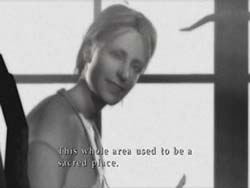
Mary refers to Silent Hill as a "sacred place".
Mary's comments regarding the place being "sacred" in the past implies that early inhabitants (probably the Native Americans) were aware of the supernatural effects of the region going back hundreds - maybe thousands - of years. Since the Natives saw the place as being "sacred" and beautiful, I tend to believe that the power did not originally manifest demons or project people's nightmares onto reality during these periods of history. Instead, I would imagine that the force (whether conscious or not) would have been more benign - maybe even benevolent.
We don't have much objective information about the Silent Hill natives' beliefs prior to the arrival of European colonists. What little we do know is possibly clouded by the lens of the European colonists and cultists.
Based on what is known about real-world Native American beliefs, it is probably safe to assume that the natives of the Toluca Lake region would likely have worshipped any regional supernatural power as "ancestral spirits" or as "spirits of nature". The Book of Lost Memories can be found in Silent Hill 2 after beating the game, and it supports this idea and tells us about the nature spirits:

"They called this place 'The Place
of the Silent Spirits'. By 'spirits',
they meant not only their dead
relatives, but also the spirits that
they believed inhabited the trees,
rocks and water around them."
- Lost Memories book (Silent Hill 2)
The name "Place of the Silent Spirits" may simply be an innocent callback to the game's title, or it could be a significant clue. The fact that the spirits were "silent" implies that the natives were not able to talk to it -- or at least, the spirits did not talk back. This implies that the "spirits" are probably not a conscious entity. Even though the power can apparently react to the thoughts - and even desires - of the people it comes in contact with, it may not have an intelligence or will of its own (which I explained in my earlier post about repressed guilt).
The natives likely would have interpreted any benevolent effects of the power (such as any magical healings, manifestations of angels, manifestations of ancenstors, manifestations of food, or good weather) as the conscious will of the spirits trying to reward them for proper worship and stewardship of the land. Any seemingly malevolent actions (such as blight, manifestations of demons or monsters, or even bad weather) would then likely have been seen as the result of having displeased the spirits, and actions would be taken to rectify that displeasure.
This would have lead to the natives establishing a set of rituals designed to interact with the spirits, ask them for favors, or appease their supposed wrath.
Many of the native tribes of the Maine region were part of the Wabanaki Confederacy, and many of those tribes shared some common beliefs. Many of them worshipped a creator-sun-deity, as well as other deities that represented other aspects of life. In many of these oral traditions, humans existed either as animals, or in an evil, violent state until some deity (sometimes the sun deity) taught them how to fish, harvest, and live in civil societies. One such character is Glooscap. Depending on the translation, Glooscap's name may mean "man who came from speech" or "man who came from nothing". Depending on the particular culture, he was either born of the sun, or he created the world, created humanity, or taught the already existent humans how to live separate from the animals.
Could it be ... Satan?
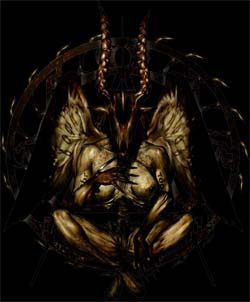
The cult's god is based on Satanic imagery.
I would suspect that the power began becoming more "evil" when European colonists started settling in the area. They were probably also aware of the supernatural powers. But, whereas the Natives saw the powers as benevolent, and fitting in with their own spiritual beliefs, the Christian Europeans probably saw it as "witchcraft" or the work of Satan. This negative image of the power probably reflected itself in the power itself, causing the area to slowly become "cursed". Disease and tragedy began to populate the region's history, and as the Europeans displaced the Natives, there were more people fearing and hating the "Satanic" power than there were people worshiping it as "sacred". This would have likely created a feedback loop in which the people's negative perception of the power began tainting the power itself, which would force the power to project more malevolence, which just made it more taboo and frightening to the settlers.
This is also mirrored in some myths regarding Glooscap, in which he becomes angry with white men for not following the rules that he gave to the native cultures.
Merging Christian paganism with native belief
At some early point in the European colonization, some settlers may have observed the demonstrably real effects of the natives' "spirits" and determined that it was the work of their own God, or of Satan. Some such believers formed a cult group that saw the very real effects of the supernatural power, and began worshiping it as their own God based on their Christian, Biblical worldview. Because the natives used complex rituals to interact with the power, the cultists probably adopted some of those rituals as well, and they would have combined them with their own European black magic rituals. It might even be the case that summoning the power required a ritual of some kind - such as the ritual that the cult raised orphans (such as Walter Sullivan) to perform on the sacred "Mother Stone" located on the Wish House premises.
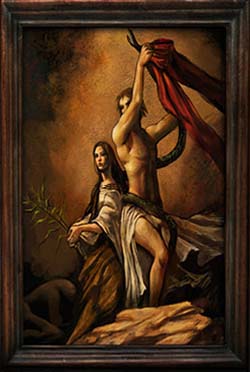
The creation myth seems to mish-mash native beliefs with elements of Genesis.
They adopted elements of the local Native's myths about the power, such as elements of the creation myths. This resulted in the creation story that is depicted in Silent Hill 3. According to the cult teachings, prior to the birth of God, humans existed in perpetual misery. This resembles the uncivilized state of humans in many Native American beliefs prior to the arrival of Glooscap (or an equivalent character).
Also, according to SH3's creation myth shown in the cult's church, a man and a woman prayed and made offerings to the sun in order to birth God. I don't know if Team Silent were aware of the Glooscap myths, but this creation story resembles the birth of Glooscap ("man who came from speech") in some native cultures. Further, the fact that the God was born of a man offering a serpent to the sun creates parallels between the creation of the cult God and the Biblical Satan, since Satan is often considered to be the talking serpent in Eden who convinces Eve to eat of the forbidden fruit. The cult's god being born of a serpent, could be symbolic of the god being "born out of Satan".
Lastly, the cult's God set out to create a paradise, but failed before she could finish it. However, the God of Silent Hill's cult isn't trying to create an ethereal heaven on another plane of existence. Rather, she set out to create a paradise on earth, similar to the Garden of Eden. This again, is a compromise between the Native and Christian beliefs. The Native Americans don't have a heaven as Christianity does, but they do believe that the world can (and should) exist in harmony. On a tangential note, this is also part of the reason why I believe that the Otherworld is not another dimension.
It's unclear how much of this creation myth existed prior to the events of the first game. The games are unclear as to whether this creation myth was always part of the cult's beliefs, or if it was invented out of whole cloth when Claudia and Vincent re-founded the church between the first and third games. Regardless, given what we see in the games, it is possible that this myth is based on a true account ("true" within the fiction of the game). Perhaps a manifestation of a god did come to a native american tribe (or even the cultists themselves) and claim to desire to create a paradise. We can't be confident of this though. Silent Hill 3 makes it clear that the cult's teachings began to shift after the first game, such that Alessa was seen as an incarnation of God, and God became more feminine. Though the god in the first Silent Hill does have feminine characteristics such as breasts, the god in Silent Hill 3 is decisively less Satanic and has a female face (resembling Alessa). So revisionist history definitely falls within the cult's wheelhouse...
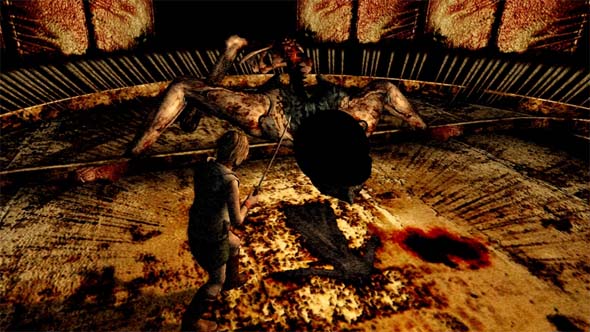
God in Silent Hill 3 is less Satanic and has a female face that resembles Alessa.
Since the Europeans saw the supernatural power as Satanic witchcraft, the cultists considered the cause to be Satan, who they began worshiping as their true God. Even though the actual creation myths began to diverge from the original Christian teachings, they continued to relate the supernatural powers to Satan. This explains why the final boss in the first game (the cult's God) is based on Satanic imagery, and why the cult objects, rituals, and seals are all influenced by Satanic beliefs and black magic symbolism. If the power began manifesting itself in forms inspired by the cult's Satanic imagery and black magic rituals, then it would have only served to further frighten the general population and make the power more taboo, contributing to the negative feedback loop.
This would happen regardless of whether the supernatural power was acting benevolently or malevolently. Malevolent action would have been interpreted by the Christian settlers as proof of the work of Satan; whereas, benevolent action would have been interpreted as Satan trying to entice the gullible with tricks.
This theme of perceiving an entity in different contexts is infamously present in Silent Hill 3. When Heather asks Vincent if he's seen the monsters that she's fighting, Vincent comments:
"'Monsters'? They look like 'monsters' to you?"
Vincent and Heather aren't necessarily seeing different things (as some fans have concluded). First and foremost, this statement probably should not be taken literally to begin with. Vincent is being deceptive. He's deliberately gaslighting Heather. But even if he were being honest and genuine in this statement, it doesn't mean they are literally seeing different things. Rather, they perceive the same thing in different contexts. Where Heather (who has no experience with the cult) considers the creatures to be ugly and demonic, Vincent (who was raised in the cult's teachings) considers them to be divine or angelic. To a Christian, an image of Baphomet is evil, reprehensible, and probably offensive; but to a Satanist, that same exact image is divine and worthy of worship and veneration. On the other side of the coin, an angel might seem like a despicable symbol of God's tyranny to a Satanist; but that same angel is ... well, angelic ... to a Christian.

What do you see? A vicious, dangerous animal? Or a cute pet?
For a more grounded analog, think about something like a pit bull dog. A stranger may see the dog as a dangerous, ugly, vicious beast that will attack on sight; but the animal's owner thinks of it as a playful, cute, beloved pet who just wants cuddles. Either way, both people see the same dog. Their life experiences and biases just color the perceptions differently.
Perhaps the monsters in Silent Hill are only aggressive because the people who encounter them project their own fear and disgust onto the monsters?
Spiraling into darkness
In the early days of the cult, their members were the victims of severe persecution. The Puritanical Christian settlers even burned some members of the cult as witches. One such member, Jennifer Carroll, is referred to in both Silent Hill 2 and 3.
Jennifer Carroll was burned by the Puritanical settlers as a witch and is honored by the modern residents.
In Silent Hill 2, a statue of her can be found in Rosewater Park where you meet Maria. The statue depicts a nun-like woman in a position of prayer or reverence, and has the following caption (parts of it are scratched out and can't be read):
"Victim of persecution
by t________ans.
Jenni___ Carroll lived
with pride and honor.
What happened here
shall never be forgotten."
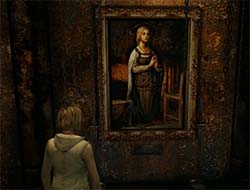
Jennifer Carroll is portrayed as a
saint in the cult's church.
A portrait of Jennifer Carroll can also be seen in the cult's church in Silent Hill 3. Here, she is portrayed in a saintly manner, and even has a halo around her head (another nod to the cult's Christian roots). The painting has a caption: "Unwavering faith under Death's blade".
Notice the decor of this painting. It strongly resembles the Otherworld, with its grimy, rust-colored background. Perhaps the cult's history of being persecuted and imprisoned has become a part of the cult's identity. Perhaps they have taken ownership of the prison surroundings in much the same way that Christains took ownership of the cross symbol.
It is probably safe to assume that Jennifer Carroll was not the only member of the cult to have been persecuted, imprisoned, and / or executed by the Christian occupants of Silent Hill. This active persecution of the cult's followers would likely also have had an effect on the powers of the town, especially if the power does have some kind of kinship with the cultists. In fact, if the power is sentient or conscious, it may even see the persecution of its worshipers as a form of persecution against itself. Or it could simply amplify the feedback loop that I discussed earlier.
This persecution could explain the many unfortunate incidents that began to tarnish the town's recorded history in the following centuries.
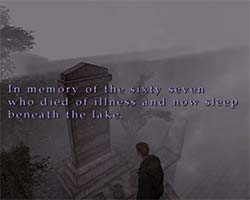
A stone monument in Rosewater Park
memorializes the victims of an epidemic.
Plague, pestilence, war, and death
With a negative feedback loop now in place, the stage was set for cycles of catastrophe for the residents of Silent Hill in the following two centuries.
The formerly successful colony was suddenly hit with an epidemic that decimated the colonial population. The town eventually had to be abandoned. What was the disease that wiped out the settlement? Was it the same parasitic infection that aflicts the nurses and doctors of Alchemilla as well as Cybil in the first game? The games don't specify what the disease was or where it came from.
There were survivors, however, and some of them were probably members of the cult (especially if the power caused the disease and spared the cult members due to their relationship to the power). It's possible that the cultists remained, or they could have fled along with the other survivors and continued to practice their rituals. Being geographically distant from the power might also have caused the cult's beliefs to further shift away from the native beliefs and towards the Euro-centric, pseudo-Christian witchcraft and black magic beliefs.
Eventually, resettlement began after the formation of a penal colony, and the cult would certainly have followed if they hadn't already stayed behind.
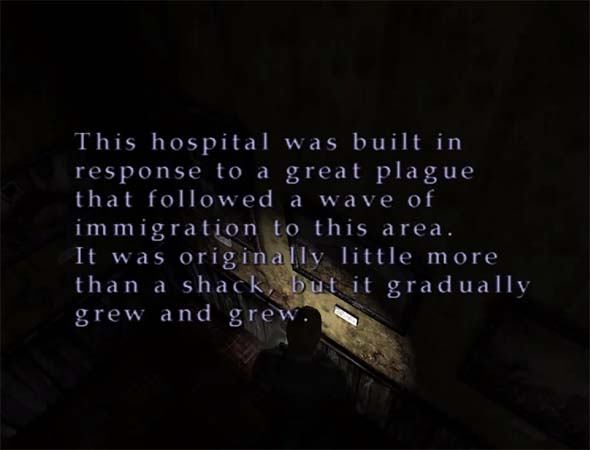
The Historical Society in Silent Hill 2 tells us about the Civil War-era prison and hospital.
A second epidemic almost forced the penal colony to be abandoned [again], but Brookhaven hospital was built, and the more advanced Civil War-era trauma and triage techniques may have helped reduce the the spread of the disease. In any case, the discovery of coal in the region brought an influx of settlers looking to work in the mines, and the economy boomed.
During this time, the cult became particularly active, and may even have made up a majority of the townsfolk. In Silent Hill, Lisa tells us a little bit about this period and the ubiquity of the cult (or "queer religion"):
"Before this place was turned into a resort,
the townspeople here were on the quiet side.
Everybody followed some kind of queer religion.
Weird occult stuff. Black Magic, that kind of thing.
As the young people moved away,
the people figured they'd been summoned by the Gods.
Evidently, things like that used to happen around here all the time."
But even with the cult's popularity apparently increasing, tragedy continued to strike. In 1918, a passenger steam ship, the "Little Baroness", sank in Toluca Lake (or while traversing a river tributary that drains into the lake). Fourteen people went missing when the ship sank, and it is presumed that their bodies lay at the bottom of Toluca Lake along with the bodies of many other victims of tragedy. An even stranger event supposedly occurred near the lake in 1939 that resulted in many deaths, but the details are unknown. Then, within 20 years prior to the first game, the staff of a development company responsible for promoting Silent Hill as a tourist destination began dying mysteriously.
These events could have been committed by the cult or its members, or they could have been caused by the town's power, or they could have been unrelated random accidents. If the cult didn't cause them, then they might have interpreted it as their god punishing the population for any number of sins.
A string of tragedies struck Silent Hill during the 20th century, leading to many mysterious deaths.
Could the cult and / or the town's supernatural power be responsible?
A legacy of conspiracy and murder
As the coal mine ran dry in the 20th century, the town's economy was re-branded for tourism to take advantage of the scenic Toluca Lake, nearby forests, and historical sites. The Historical Society was built on top of the old prison, the Lakeside Amusement Park and Hotel were opened along the lake, and a national park was eventually established only miles away from the town.
The cult took advantage of the tourism trade to sell a hallucinogenic drug called "P.T.V." to tourists. The drug was fashioned from the White Claudia plant native to the region. This plant may also be a primary ingredient of the demon-warding aglaophotis substance, and so was likely harvested by the cultists to protect themselves. The money from the sale of the drug was used to fund the growth of the cult, including the construction of churches, recruitment of members, construction and maintenance of an orphanage at which the cult brainwashed children into believing, and possibly to pay for the salaries of clergy.
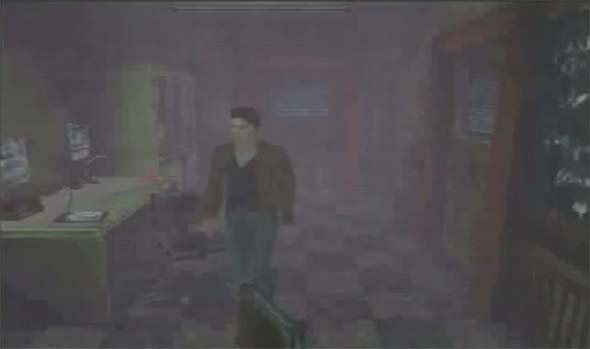
The police of Silent Hill were investigating a drug ring at the time of the first game.
It's possible that the cult was responsible for originally promoting the town as a tourist destination. The influx of visitors gave them plenty of opportunity to sell their hallucinogenic White Claudia drugs. They partnered with Alchemilla hospital to manufacture and distribute the drug, but eventually attracted the attention of the police. Investigations began, but the detectives assigned to investigate also died of mysterious causes.
A blackboard in the police station of the first game describes the state of the investigation:
"Product only available in selected areas of Silent Hill.
Raw material is White Claudia, a plant peculiar to the region.
Manufactured here?
Dealer = manufacturer?"
Another note in the same police office summarizes a coroner's report stating that officer Gucci (presumably investigating the drug ring) had died of a suspicious heart attack.
Players who complete the Kaufman side quest in the resort area of Silent Hill will find several other documents and a drug stash that implicates Dr. Kaufman as being involved in the drug ring. Kaufman was probably using his position within the hospital to use the facility's labs and equipment to manufacture the drug (as well as the demon-warding aglaophotis), and he may have been selling it to patients and other employees. Nurse Lisa Garland is an addict of the drug, and may even have died of an overdose of the drug (depending on how you interpret her death scene in the game).
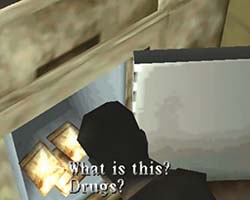
Drugs in the Indian Runner bar.
Contrary to his appearance in Origins, I don't think the first game ever clarifies whether Kaufman is an actual member of the cult, or if he is just an accomplice. He knows about the demon-warding potential of aglaophotis and keeps secret stashes hidden away, and he acts to cover-up Alessa's immolation and survival. But he doesn't seem at all interested in Dahlia's plan to birth the god, and in fact acts in opposition to those plans. He also does not express any familiarity with the creatures that he encounters or the Otherworld, implying that he has no prior experience with the supernatural powers that the cult worships.
Harmful actions taken by Dahlia and the cult leadership may have been the final nail in the coffin. In addition to the general public feeling uneasy or afraid of the power, now its own worshipers were using its powers for evil. What used to be sacred and divine to the native inhabitants was now a tool for self-serving fortune-seekers and apocalyptic conspirators. The increasing strength of the power, the cycle of tragedies, and the conspiratorial actions of the cult all culminated in the birth of a psychic girl named Alessa, and the events of the Silent Hill games.
All along the cult had been influencing the development of the region, either through their minority persecution in the early days, or through their majority conspiracies in more recent history. They directly and indirectly influenced the politics of the region and may even have been responsible for initiating the town's tourist trade. But most importantly, their relationship with the local supernatural power seems to have twisted that power into a malevolent entity that feeds on misery and seems to see only the deepest, darkest evil within the people who come in contact with it.
Or perhaps the town is literally cursed?
There is another, simpler explanation: the town may just be literally cursed. There isn't much to back this up directly, except for a second-hand line from Lisa in the first Silent Hill game:
"Last time I heard anything about it was...
gosh, years ago.
When several people connected with developing the town died in accidents.
People said it was a curse."
Maybe that's it, right there! Maybe the town is just cursed. Maybe it always was.
Alternatively, as the European settlers displaced the Native Americans and usurped their religion, perhaps the natives placed a curse on the region before relocating. Such a curse could have been specifically designed to cause disease and mysterious deaths and maybe even manifest demons. Or it could have been a more subtle curse that forces people's darkest nightmares to become reality. This would explain the town's unfortunate history, and the existence of the Otherworld. In this case, the cult could have begin worshiping the curse, and that worship eventually lead to cult members being able to directly or indirectly manipulate the powers of the curse to suit their own needs, thus feeding into their power.
Whether it's the primary cause or not, in a game world in which black magic and psychic powers appear to be real phenomena, an indigenous curse could definitely be part of the puzzle. It could either be a supplement to the feedback loop theory outlined above, or possibly an outright (though poorly-supported) replacement.
UPDATE: 8 March, 2018:
Something that was pointed out to me during a recent play-session for On the Branch's Silent Hill episodes is the idea that perhaps, instead of a vague "spiritual power", the town is literally possessed by an actual demon. This is (I'm a bit embarrassed to admit) something that had never even occurred to me until it was pointed out. The final boss of Silent Hill and Silent Hill 3 could possibly just be an avatar of the same malevolent demon that the natives were worshiping, rather than some kind of manifestation of what the cultists think the god should be. Or maybe the demons wasn't always malevolent, and it was tainted by the European colonists' influence in the same way that I described the spiritual force becoming tainted above.
After all, if the cultists belief that God will return and reshape the world is to be taken at face value, then it makes sense that the demon god that they worship has the power to do that. In that case, the god would also have the power to create the very monsters that are manifested.
While it's an idea worth considering (especially to someone who has only played the first game), I don't really put much stock into this interpretation. All the rest of the monsters in the games are manifestations from the psyches of one or more characters in the game. I see no reason why the final boss (the demon god) should be any different. I also don't feel that the games support the idea of the power having a conscious will (at least not until Downpour).
Silent Hill's history is a history of the cult
While the specific details of the cult's history, and the nature of the supernatural powers, are vague, it is still apparent that the cult has played an integral role in the history of the town and this power, and thus in the games themselves. Without the cult, Silent Hill would not be what it is, and its occupants and visitors would not have the experiences that they do.
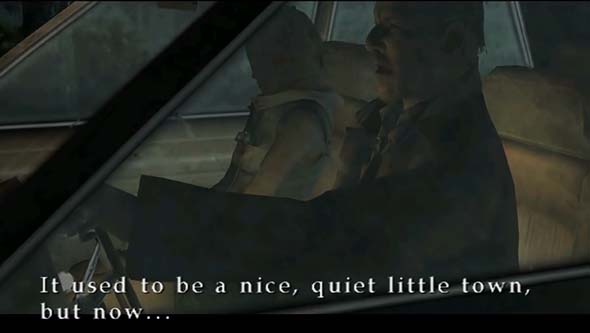
What happened? The cult happened. That's what.
I acknowledge that it isn't necessary for future games' plots to be about the cult. It is, however, important that any future games respect this history, and to hopefully add something meaningful to it. It is also important to consider the context of the cult's beliefs and goals in any discussion of the town's power or the Otherworld. Without respect for the cult underpinnings of the original games, any new games run a severe risk of being a mere ghost story with little or no real connection to the rest of the franchise. That doesn't necessarily mean that such a game can't be good on its own right, but it would be skating on thin ice, and might still feel out of place within the series canon (much like how Downpour feels now). Hopefully Hideo Kojima and his staff working on Silent Hills the writers of any potential future Silent Hill games will understand this.